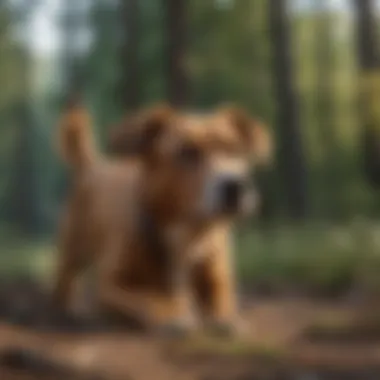Unraveling the Intriguing Canine Behavior: The Science Behind Why Dogs Shake Themselves


Pet Care & Tips
Taking care of a dog involves understanding its breed-specific requirements, lifestyle preferences, and health considerations. When choosing a pet dog, factors such as size, energy levels, grooming needs, and temperament should be taken into account to ensure a suitable match for the owner's living situation and activity level. Basic care requirements include providing appropriate nutrition, exercise, grooming, and veterinary care to maintain the dog's overall well-being. Training techniques and behavioral enrichment ideas play a vital role in fostering a positive relationship and ensuring the dog's mental and physical stimulation.
Introduction
Dogs shaking themselves is a behavior that captures the curiosity of many pet owners and animal enthusiasts. This article aims to delve into the intricacies of this common canine habit, shedding light on the underlying reasons that drive this behavior. By thoroughly examining the biological, evolutionary, and practical aspects of dogs shaking themselves, readers will embark on a journey to gain a deeper understanding of their furry companions' instincts and needs.
Overview of Dog Behavior
Understanding dog behavior is essential for pet owners to establish strong bonds with their canine friends. Dogs communicate through a variety of behaviors, including shaking themselves. This section will explore the significance of observing and interpreting a dog's actions to better comprehend their thoughts, emotions, and responses to stimuli.
Importance of Understanding Canine Actions
Delving into the intricacies of canine behavior goes beyond simple observation; it symbolizes a deeper connection between humans and their four-legged companions. Unraveling the mysteries behind why dogs exhibit certain actions, such as shaking themselves, can provide valuable insights into their well-being, psychology, and overall health. Approaching this topic with a curious mind not only enhances the owner-pet relationship but also fosters a more empathetic and informed pet care approach.
Biological Perspectives
In examining the behavior of dogs shaking themselves, it is imperative to delve into the biological perspectives that underpin this common canine habit. Dogs shaking themselves is not merely a superficial action but is deeply rooted in the intricate functioning of their fur and skin. Understanding the biological aspects of this behavior provides essential insights into the physiological mechanisms at play and the significance of such actions in a dog's daily routine.
A fundamental element to consider when discussing the biological perspectives of dogs shaking themselves is the role of fur and skin in their overall well-being. The interplay between a dog's fur and skin serves purposes beyond aesthetics; it plays a crucial role in thermoregulation, protection against environmental elements, and even communication with other animals. By exploring how a dog's fur and skin contribute to the shaking behavior, we can unravel the layers of complexity that shape this instinctual act.
Role of Fur and Skin
The role of fur and skin in a dog's life extends far beyond adornment; it is a sophisticated system tailored by evolution to ensure the animal's survival and well-being. A dog's fur acts as a shield, providing insulation against temperature fluctuations and safeguarding the skin from potential injuries. Furthermore, the distinct texture and distribution of fur in different body regions enable precise communication and sensory perception, enhancing the dog's interaction with its environment.
Natural Grooming Instincts


Beyond the physical protection and sensory prowess, a dog's grooming instincts are deeply intertwined with its biological essence. The act of shaking is not merely a random gesture but a structured grooming behavior ingrained in the genetic code of canids. Through shaking, dogs efficiently remove dirt, debris, and parasites from their fur, promoting hygiene and health. This natural grooming ritual not only preserves the dog's cleanliness but also signifies a connection to its wild ancestors, where such actions were vital for survival in the rugged environment.
Evolutionary Insights
In this section, we delve into the intricate world of Evolutionary Insights regarding why dogs shake themselves. At the core of understanding this behavior lies a deep connection to the past, where the behavior of ancestral canids sheds light on the motives behind our modern-day canine companions' actions. Exploring Evolutionary Insights offers a unique perspective on how certain behaviors have stood the test of time and remain relevant in the canine world today.While showcasing the relevance of Evolutionary Insights in this article, we aim to highlight the intricate web of reasons that link our furry friends to their ancient counterparts. By acknowledging these connections, we can gain a more profound understanding of the innate tendencies that drive dogs to shake themselves.
Behavioral Remnants from Ancestral Canids
Diving deeper into the realm of Evolutionary Insights, we uncover Behavioral Remnants from Ancestral Canids that contribute to the shaking behavior observed in dogs. These remnants serve as echoes from the past, offering glimpses into the survival strategies of early canids that have transcended generations. By examining these behavioral remnants, we unravel the tapestry of traits that have been passed down through evolutionary channels, shaping the behavior of present-day domesticated dogs. Understanding these remnants provides a gateway to comprehending the primal instincts that underpin dogs' shaking behavior, offering a unique perspective on their actions and motivations.
Survival and Communication Functions
Within the framework of Evolutionary Insights, Survival and Communication Functions play a pivotal role in deciphering why dogs shake themselves. Survival functions are deeply rooted in the need to adapt to environmental challenges and ensure the well-being of the individual and the pack. By exploring how shaking behavior aids in survival, we can appreciate the multifaceted nature of this seemingly simple act. Moreover, Communication Functions shed light on the role of shaking as a form of expression among canids. Through subtle cues and signals, dogs communicate vital information to their peers, enhancing social cohesion and understanding. By peeling back the layers of survival and communication, we uncover a rich tapestry of evolutionary development that has sculpted the behavior of dogs over millennia.
Psychological Aspects
As we delve into the intricate behavior of dogs shaking themselves, the segment on Psychological Aspects holds a pivotal role in unraveling the layers of canine cognition and emotion. Understanding the psychological underpinnings behind why dogs engage in this distinctive behavior offers us a profound insight into their inner world and psyche. By focusing on the Psychological Aspects, we illuminate the mindset of dogs, shedding light on the emotional triggers and responses that drive their actions. This exploration not only enhances our comprehension of canine behavior but also cultivates a deeper bond of empathy and connection with our furry companions.WindicatorsW
Stress Release Mechanisms
Within the realm of canine behavior, Stress Release Mechanisms play a significant role in how dogs regulate their emotional well-being. By shaking themselves, dogs exhibit a natural coping mechanism to alleviate stress and anxiety that may arise from various situations and environmental stimuli. Understanding the intricate ways in which dogs use shaking as a tool for stress relief enables us to provide better support and care for our canine friends. Unraveling the nuances of Stress Release Mechanisms in dogs allows us to respond effectively to their needs and create a harmonious environment that promotes their mental health and overall well-being.
Comfort Seeking Behavior
Another intriguing facet of dogs shaking themselves is the Comfort Seeking Behavior they display through this action. Dogs often engage in shaking as a means to seek comfort and reassurance, especially in situations that may be overwhelming or unfamiliar to them. By observing and acknowledging this Comfort Seeking Behavior, we gain valuable insights into our dogs' emotional needs and preferences. Recognizing shaking as a comforting gesture helps us cater to our pets' emotional well-being, fostering a sense of security and trust in our relationship with them. This section delves deep into the nuances of Comfort Seeking Behavior in dogs, highlighting the importance of emotional support and understanding in our interactions with these loyal companions.
Environmental Factors


Environmental factors play a crucial role in influencing a dog's behavior, particularly their shaking actions. Understanding the impact of the environment is vital in comprehending why dogs shake themselves. Dogs respond to various stimuli in their surroundings, which can trigger shaking behavior as a means of adapting or responding. Factors such as temperature, humidity, and external stimuli can all influence how often and intensely a dog shakes itself.
Temperature Regulation
Temperature regulation is a primary aspect of environmental factors that affect a dog's need to shake. Dogs lack sweat glands like humans and rely on alternative methods to adjust their body temperature. Shaking is one such mechanism that helps dogs dissipate excess heat or maintain warmth when it's cold. By shaking, dogs can improve blood circulation, control heat loss, and regulate their body temperature efficiently.
External Stimuli Response
Apart from temperature, dogs can also shake themselves in response to external stimuli. This could include exposure to water, unfamiliar scents, or physical discomfort. Dogs may shake after being in the rain to dry off, or when they encounter a new smell to mark territory or show discomfort. Understanding how dogs react to external stimuli through shaking provides insights into their sensory perceptions and natural instincts.
Health and Hygiene Considerations
In this erudite discourse on why dogs shake themselves, the segment on Health and Hygiene Considerations stands as a pivotal cornerstone, indispensably vital for any discerning reader keen on comprehending the intricate world of canine behavior. Delving into the realms of dog hygiene transcends mere grooming routines; it unearths a profound connection between a dog's physiological well-being and its shaking behavior. Understanding the significance of maintaining a dog's health and hygiene not only enhances its overall quality of life but also serves as a window into its intrinsic needs and natural instincts. By meticulously examining the role of hygiene in a dog's routine, one can decipher subtle cues that reflect the animal's state of being.
Skin and Coat Maintenance
Expatiating further on the discussion around Health and Hygiene Considerations leads us to the vital aspect of Skin and Coat Maintenance. This component encompasses a spectrum of practices and routines aimed at preserving the integumentary health of our canine companions. The dog's skin and coat serve not only as protective barriers against external elements but also as indicators of its internal health status. Proper maintenance of the skin and coat involves a harmonious blend of diet, grooming, and environmental factors. Understanding the correlation between a dog's shaking behavior and the condition of its skin and coat unveils a narrative of care, attention to detail, and symbiotic relationship between pet and caretaker.
Parasite Removal Mechanisms
The saga of Health and Hygiene Considerations would be incomplete without a meticulous exploration of Parasite Removal Mechanisms. Parasites pose a constant threat to a dog's well-being, prompting innate defense mechanisms such as shaking to rid itself of these unwanted freeloaders. Examining the intricate ways in which dogs instinctively address parasite infestations sheds light on their adaptive capabilities and survival instincts. By dissecting the nuances of parasite removal through shaking behavior, one gains a profound appreciation for the evolutionary resilience ingrained in every canine. This in-depth elucidation paves the way for a more profound understanding of the symbiosis between dogs and their environment, encapsulating a holistic perspective on the essence of canine hygiene and well-being.
Training and Behavior Modification
In this article, the focus shifts towards Training and Behavior Modification, a crucial aspect in understanding dogs' shaking behavior. Training and Behavior Modification play a pivotal role in shaping canine actions and responses. By delving into this topic, readers will gain insights into the specific elements that influence how dogs shake themselves. Understanding these elements is vital for pet owners and educators alike to enhance their bond with their furry companions.
Training and Behavior Modification can offer numerous benefits when addressing why dogs shake themselves. Through structured training methods, pet owners can effectively manage and reduce undesirable shaking behaviors in their dogs. Consistency and patience are key elements in any training regime, ensuring that dogs learn and adapt to more appropriate responses. Moreover, employing positive reinforcement techniques can result in long-lasting changes in behavior, creating a positive and enriching environment for both the dog and its owner.


When considering Training and Behavior Modification in relation to dogs shaking, certain considerations come into play. It is essential to tailor training approaches to suit the individual dog's temperament and needs. What works for one dog may not be effective for another, making customization a critical component of successful behavior modification. Additionally, understanding the underlying reasons for a dog's excessive shaking is integral to designing an effective training plan. By identifying triggers and specific behaviors, pet owners can address shaking issues more efficiently.
Positive Reinforcement Techniques
Positive reinforcement techniques are fundamental to shaping desired behaviors in dogs. In the context of shaking behavior, positive reinforcement involves rewarding dogs for exhibiting calm and relaxed states. For example, when a dog refrains from excessive shaking after a bath, offering treats or verbal praise reinforces this desirable behavior. Positive reinforcement creates a direct correlation between appropriate actions and positive outcomes, motivating dogs to repeat these behaviors.
Implementing positive reinforcement techniques requires consistency and precision. Pet owners should reward desired behaviors immediately to strengthen the connection between the action and the reward. Using high-value treats or engaging in play as a form of positive reinforcement can effectively encourage dogs to exhibit favorable behavior patterns. By reinforcing calmness in moments when a dog would typically shake, owners can gradually diminish excessive shaking tendencies.
Addressing Excessive Shaking Behaviors
Excessive shaking behaviors in dogs can stem from various factors, including anxiety, discomfort, or medical conditions. Addressing these behaviors is crucial to improving a dog's quality of life and well-being. Pet owners need to observe their dog's shaking patterns and identify triggers that lead to excessive shaking episodes. Once the triggers are recognized, targeted interventions can be implemented to help the dog manage stress or discomfort more effectively.
When addressing excessive shaking, a holistic approach is recommended. This approach entails addressing underlying issues that may contribute to the behavior, such as anxiety or skin irritation. Consulting with a veterinarian or animal behaviorist can provide valuable insights into the best course of action. In some cases, behavior modification techniques, in conjunction with veterinary care, may be necessary to alleviate excessive shaking behaviors.
Overall, Training and Behavior Modification are instrumental in addressing and managing why dogs shake themselves. By utilizing positive reinforcement techniques and targeted interventions, pet owners can foster healthier behaviors in their canine companions, promoting a harmonious relationship built on trust and understanding.
Conclusion
In delving deep into the complex behavior of why dogs shake themselves, it becomes apparent that this seemingly simple action holds much significance in understanding our canine companions. Throughout this article, we have meticulously dissected the multiple layers of reasons and implications behind dogs' self-shaking behavior.
One of the key elements to grasp from this exploration is the innate biological underpinnings that drive dogs to shake themselves. Understanding that dogs have natural grooming instincts rooted in their ancestral lineage provides a profound insight into why this behavior persists even in domestic settings. By acknowledging these biological imperatives, pet owners and enthusiasts can develop a deeper appreciation for the intrinsic nature of dogs and their inherent tendencies.
Furthermore, the evolutionary perspectives uncovered in this analysis shed light on the adaptive functions of shaking behavior in canids. From facilitating communication to aiding in survival strategies, the act of shaking carries echoes of past necessities that continue to shape modern canine actions. By recognizing these evolutionary remnants, individuals can better comprehend the nuanced ways in which dogs navigate their environment and interact with their peers.
In practical terms, elucidating the psychological aspects tied to shaking reveals crucial insights into dogs' stress release mechanisms and comfort-seeking behaviors. By acknowledging the role of shaking in these contexts, owners can better support their pets in coping with various emotional states and environmental stressors. This awareness can lead to more empathetic and responsive care practices, fostering stronger bonds between humans and dogs.
Moreover, considering the environmental factors that influence dogs' shaking habits, particularly in regulating body temperature and responding to external stimuli, offers a holistic perspective on this behavior. By recognizing how dogs use shaking as a tool to maintain their physical well-being and adapt to their surroundings, individuals can ensure a more conducive and comfortable living environment for their furry companions.
When it comes to health and hygiene considerations, the links between shaking and skin & coat maintenance as well as parasite removal mechanisms become apparent. By understanding the dual role of shaking in keeping dogs clean and free from pests, pet owners can implement appropriate grooming routines and preventive measures to safeguard their pets' well-being.
Finally, from a training and behavior modification standpoint, the discussion around positive reinforcement techniques and addressing excessive shaking behaviors emphasizes the role of education and consistent guidance in shaping dogs' actions. By leveraging positive reinforcement to encourage desired behaviors and address problematic shaking patterns, individuals can foster healthier and more harmonious relationships with their canine companions.
Overall, the journey through the intricacies of why dogs shake themselves serves as a testament to the depth of canine behavior and the multifaceted reasons that underpin even the simplest of actions. By immersing ourselves in this exploration, we not only gain a deeper understanding of our furry friends but also cultivate a profound appreciation for the rich tapestry of instincts, adaptations, and communication mechanisms that make dogs such remarkable companions.







